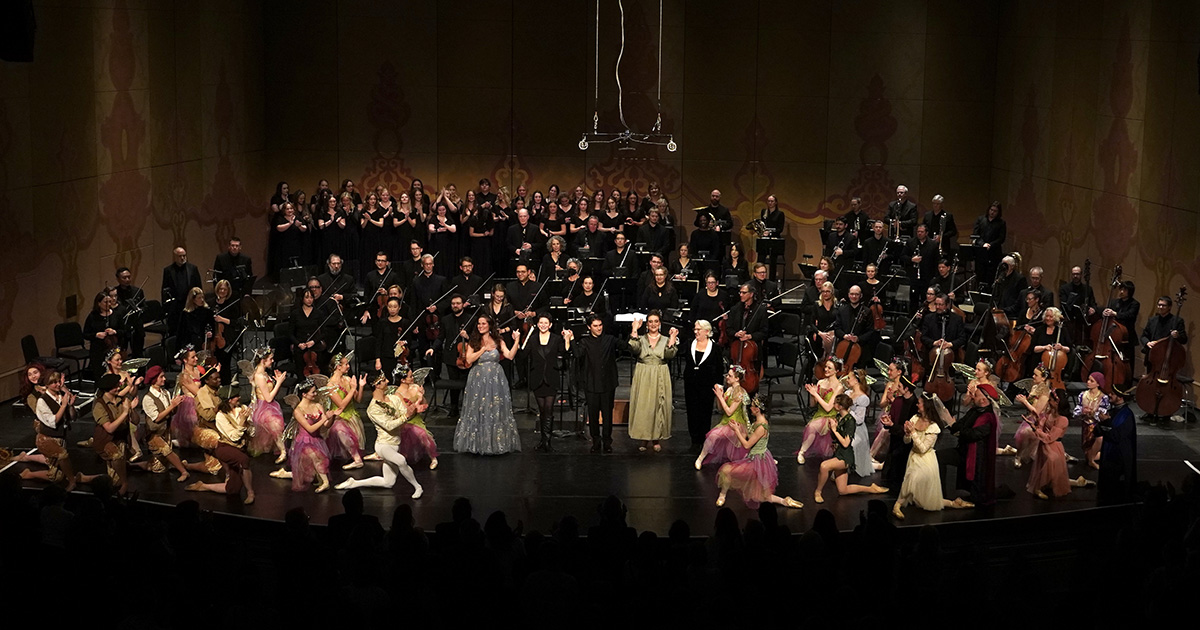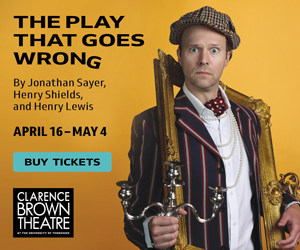Knowing what we know about Felix Mendelssohn and his artistic attractions and interests, it is exceedingly likely that he would have been superbly delighted with the Knoxville Symphony Orchestra’s adventure into A Midsummer Night’s Dream on this past weekend’s Masterworks concerts. Not only did the evening include Mendelssohn’s amazingly mature A Midsummer Night’s Dream concert overture, Op. 21, written when he was 17 years old, but also his Op. 61 incidental music for the play composed 16 years later that includes parts for two sopranos and choirs. Maestro Aram Demirjian didn’t stop there, though, adding excerpted Shakespearean text delivered as a clever narration plus the visual feast of ballet storytelling. The KSO’s partners in all this were Laura Beth Wells as the Narrator, sopranos Jacqueline Brecheen and Tori Franklin, the Webb School of Knoxville Chamber Singers, Pellissippi State Community College Variations, and 27 members of the Appalachian Ballet Company choreographed by Amy Morton Vaughn.
Admittedly, adding other media to music in the concert hall often proves an unnecessary distraction. In this case, however, the inclusion was a completely natural one that offered a context for the Mendelssohn score and gave just enough of the theatrical storytelling to tie it to the Shakespeare play. Carefully considered, too, were the technical and visual aspects. The orchestra players were given individual stand lights so that the Narrator and the dancers could be lit dramatically and effectively. The entirety of the Tennessee Theatre’s stage apron was floored for dance and dedicated to the ballet sequences.
The result was a combination of orchestral and vocal music reaching into the visual performing arts that worked superbly. Narrator Wells—a master of voice inflection and dramatic delivery—beautifully evoked the Shakespearean characters, bringing them to life with a variety of accents and energies. Sopranos Brecheen and Franklin were perfectly matched to the lyrically delicate and sparkling Mendelssohn passages. The choirs, necessarily tucked into the upstage corner, handled the character of their work crisply and nicely balanced against the orchestra.

Mendelssohn’s Overture is as perfectly evocative of the Shakespearean dream world of Puck, Oberon, Titania, and a host of fairies as one could hope. For this, the KSO strings captured the soft shimmer of a magical forest, alive with whispers and woodland intrigues. As the overture gives way to the 13 movements of the incidental music, Demirjian, orchestra, and dancers came together as a theatrical whole. The KSO horns (Principal Horn Jeffery Whaley) had a night of satisfying majesty as did the bassoons (Principal Bassoon Duncan Henry) notably in the Nocturne (Con moto tranquillo). Again, the strings were simply magical in capturing the effect of moonlit forest. Of course, the stately Wedding March always brings smiles.
It should be noted here that the KSO and Appalachian Ballet are not strangers to each other. The December holiday season brings ABC’s traditional production of The Nutcracker, for which the KSO performs live, something of a rarity for regional ballet companies.
Although Ms. Vaughn’s dancers were without a complete theatrical environment, the collaboration worked well for the audience and probably created some new ballet followers. The ABC leads were James La Russa as Oberon and Laura Morton La Russa as Titania. Kayla Ferguson was a superbly energetic and nimble Puck.
With A Midsummer Night’s Dream comprising the second half of the evening’s concert, Maestro Demirjian had the interesting task of filling the first half with pieces that would not wilt in the audience’s memories under the theatricals to follow. The evening opened with Ruth Crawford Seeger’s Rissolty, Rossolty. Although Seeger was firmly in the postwar musical avant-garde, Rissolty, Rossolty represents a simpler approach that toys with folk-driven polyphony and layering that suggests Ives. Interestingly, the work does not really end, but simply shuts down, as if overtaken by chaos. Knoxville audiences should consider themselves lucky to have heard this rarely performed work.
That audience sentiment probably didn’t include the second work of the evening, Cantus arcticus: Concert for Birds and Orchestra by the Finnish composer Einojuhani Rautavaara. The 1972 work that includes orchestra and a recorded track of bird sounds felt solidly in the 1970s idea of combining live music with recorded, possibly electronic, media. In this case, from my perch in the balcony, the recorded sound overwhelmed the orchestra’s contribution, doing in the work’s significant use of dynamics.
Smetana’s “The Moldau,” one of the six symphonic poems from Má vlast, concluded the first half, perhaps anticipating the evocation of a landscape—not one belonging to fairies and mischievous sprites, but one of the river that runs through Prague. The work was deliciously programmatic and performed with marvelous riparian intensity, with strings and winds taking the lead depicting the movement of the water—surging and ebbing—all the while marking events in the Bohemian forest along the way.





